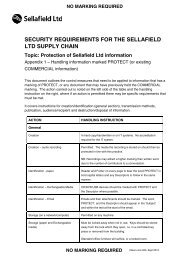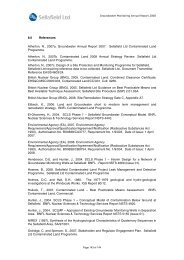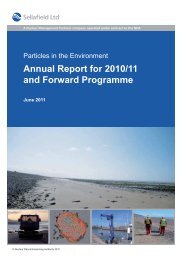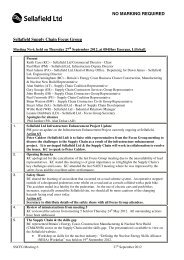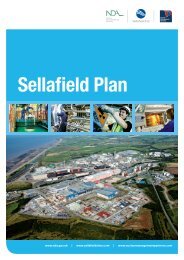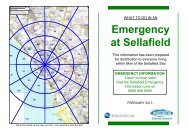Procurement Plan Strategy - Sellafield Ltd
Procurement Plan Strategy - Sellafield Ltd
Procurement Plan Strategy - Sellafield Ltd
You also want an ePaper? Increase the reach of your titles
YUMPU automatically turns print PDFs into web optimized ePapers that Google loves.
Name Signature DatePrepared By Mark Evans 28 April 2011Approved By Keith Case 28 April 2011Page 2 of 23
ContentsPage1.0 Introduction 42.0 Mission 43.0 Strategic Outcomes 44.0 The Commercial Change Programme 55.0 The <strong>Sellafield</strong> Approach to <strong>Procurement</strong> 65.1 Make Buy 75.2 Acquisition <strong>Strategy</strong> 75.3 Sourcing and Contract <strong>Strategy</strong> 96.0 <strong>Procurement</strong> Principles and Practices 117.0 Commercial Systems and Purchasing Routes 147.1 Commercial Systems 147.2 Purchasing Routes 158.0 <strong>Procurement</strong> <strong>Plan</strong>ning 168.1 The <strong>Procurement</strong> <strong>Plan</strong> 168.2 Key Steps in the Process / Cycle 169.0 The Organisation of the Commercial Directorate 1810.0 Our People 2010.1 Capability Development 2010.2 Roles, Responsibilities and Reporting 21Appendices1 Operating Model of the Commercial Change Programme 222 Breakdown of <strong>Sellafield</strong> External Expenditure by Commodity(2010/2011)23Page 3 of 23
<strong>Sellafield</strong> <strong>Procurement</strong> <strong>Plan</strong> <strong>Strategy</strong>1.0 IntroductionThis document describes the <strong>Procurement</strong> <strong>Strategy</strong> of <strong>Sellafield</strong> (from mission through topolicy, process and organisation) and how this aligns with the submission of the procurementschedule. It forms the first half of the <strong>Sellafield</strong> <strong>Procurement</strong> <strong>Plan</strong>, the second half being the<strong>Procurement</strong> Schedule, a list of proposed procurements required to support delivery of the<strong>Sellafield</strong> Lifetime <strong>Plan</strong> for 2011.The supply chain makes a crucial contribution to the operations of <strong>Sellafield</strong>, with over half ofits annual site funding limit, circa £800M per annum, being spent via <strong>Procurement</strong> activity in2010/11. The continued safe, effective and efficient operation of <strong>Sellafield</strong> therefore requireseffective management of this expenditure.2.0 MissionThe mission of <strong>Sellafield</strong>’s Commercial Directorate is:To deliver sustainable commercial solutions to meet or exceed stakeholder requirements:• Allowing us to maximise value• Allowing us to maximise fee• Balancing risk and opportunity• Working to our values and developing our people.3.0 Strategic OutcomesThe key strategic outcomes of the <strong>Sellafield</strong> Commercial Directorate are as follows:• Delivery of the “daily plan” - supporting users by sourcing and procuring the supply chainrequirements that they need on a daily basis• Increased stakeholder confidence and enhanced Environmental, Safety, Health andQuality performance of supply-side managed activities• The enabling of acceleration in hazard reduction, by reducing waiting time in theprocurement process. (The Directorate target is to reduce waiting days by 150,000 overfive years)• Supporting the delivery of supply chain efficiency savings for the site, whilst maintainingor increasing the scope and quality of work. (The <strong>Sellafield</strong> target is to reduce supplychain expenditure by £500M over the five year time period)• Enhanced Commercial Directorate and supply chain efficiency and service. (TheDirectorate target is to improve efficiency by 20% / £12M, over the five year time period);• Optimisation of fee income• Avoidance of fee abatement.Page 4 of 23
4.0 The Commercial Change ProgrammeThe Commercial Change Programme is a transformation programme with two distinctobjectives but shared areas of focus, namely:• Improving the efficiency and effectiveness of the Commercial Directorate,whilst• Supporting site imperatives, including supply chain efficiencies andexpenditureAs such, it is a key element of the site’s Integrated Change Programme enabling informedprocurements.The programme was initially established in response to the <strong>Sellafield</strong> PAIS (Partner-Assess-Innovate-Sustain) review. It has subsequently been extended in scope and is now focusedon delivering <strong>Sellafield</strong> strategic requirements, in particular the requirement to secureimprovements in supply chain quality management. Its high-level targets can therefore besummarised as:• Acceleration of high hazard reduction• Functional efficiency reduction of 20%• Supply Chain expenditure reductions of £500M• Improved stakeholder engagement and confidence• Improved supply chain quality management.• Developing & maintaining a capable supply chain• Enhance commercial capability throughout the businessThe Commercial Change Programme will make a significant contribution to the future of<strong>Sellafield</strong> and the achievement of its mission. It is a fully resourced programme, withExecutive level support and involvement. The operating model of the programme is depictedin Appendix 1. The seven work streams of the current programme are listed and summarisedbelow.Process and Operations Management - Improve procurement process cycle times andefficiency; simplify documented procedures and migrate to the new <strong>Sellafield</strong> ManagementSystem structure. These changes will enable the acceleration of high hazard reduction viareductions in waiting times, as well as underpinning Commercial and operational efficiencyimprovements. This work stream also covers the review and development of organisationaland process performance measures.Supply Chain Quality Improvement - Develop and implement an enhanced supplierassurance programme; supply chain development; improve the demand-side capability ofprocurement process users; and improve procurement processes related to quality;contractor management control & oversight. These improvements will reduce the number ofPage 5 of 23
5.1 Make-Buy<strong>Sellafield</strong> employs a rigorous make-buy decision-making process, which has been agreedand approved by key stakeholders and is a neutral decision making tool. Discussions onwhether <strong>Sellafield</strong> should produce goods or services in-house (make), source them from thesupply chain (buy), or use a combination of the two are put forward to the Executive forapproval. Many relevant and detailed factors are considered in making this decision,including; consideration of comparative efficiencies and labour mobility; redeployment costs;and the allocation of risk between the NDA, <strong>Sellafield</strong> and the supply chain. Decisions onmake-buy may result in a change to in-house activity and / or a change in supply chainactivity. Once the decision to buy has been made, appropriate acquisition strategies aredeveloped.5.2 Acquisition <strong>Strategy</strong>In order to decide how to procure goods, services or works, <strong>Sellafield</strong> reviews the optionsavailable, considers key factors and employs specific procurement tools to ensure that thecorrect decision is made. <strong>Sellafield</strong> is required to comply with the Public ContractsRegulations, which requires all procurement and contracting decisions to be made within theboundaries of this legislation. Options considered include competition, frameworkagreements, framework contracts, sole sourcing, collaborative procurement, and thedevelopment of alliances with suppliers. Key factors affecting the choice of acquisitionstrategy include consideration of NDA Drivers, securing the efficiency targets and meetingthe requirements of the Regulatory Environment / Nuclear Site Licence Conditions. NDADrivers include:• Requirements to comply with the conditions of the M&O Contract• The objectives to accelerate hazard reduction and obtain value for money• Securing efficiencies via collaboration with other SLCs• The development of a competitive local supply base• Working within the NDA Supply Chain Development <strong>Strategy</strong>.One of the key procurement tools used to support decisions on acquisition strategy isPurchasing (Kraljic’s) Portfolio Analysis. This is a two-by-two matrix which considers theoverall spend on the item, as well as the level of risk associated with its procurement. Foreach item, its position on the matrix is identified, which then suggests how to procure theitem. After consideration of the factors and constraints described above, in particular thePublic Contracts Regulations, an optimal acquisition strategy is then identified, whichincludes the commercial model to drive the desired behaviours and outputs required.Portfolio Analysis is depicted in Figure 1 below, along with an indication of the strategiesemployed for each type of expenditure. More detail on how the tool is applied is givenoverleaf. This tool is one of several facets that are considered when developing anPage 7 of 23
acquisition and sub-contract strategy; other considerations such as those outlined above arealso taken into account.Figure 1 Purchasing Portfolio Analysis at <strong>Sellafield</strong>RISK / EXPOSURE HighLowStrategic SecurityRelatively low spend; few suppliers -possible monopoly; high risk anddependencySeek alternatives, question IPR or closerelationship with supplier, increase spendTactical AcquisitionLow spend, many suppliers, low risk anddependency, relatively high processcostsCall off agreements / purchase cards; e-procurement, outsourcedStrategic CriticalHigh spend; few suppliers - possiblemonopoly; high risk and dependencyPartner with suppliers, joint ventures,joint projectsTactical ProfitHigh spend; many suppliers; low riskand dependencyPlay the market; short contracts;benchmarkLowSPENDHighHow <strong>Sellafield</strong> applies Purchasing Portfolio AnalysisStrategic Critical – Spend in this category is relatively large, with a small number ofpotential suppliers. Items in this quartile are often of core importance to <strong>Sellafield</strong>. For theseareas, Commercial would prefer to work closely with suppliers, developing partnering-typerelationships, running joint improvement programmes, and ensuring that both parties benefitfrom the arrangement over the long term. In this way, the risk of supply discontinuities isreduced, performance can be closely monitored, whilst the supplier can make reasonableprofits from the associated contracts.Tactical Profit – Spend in this category is relatively large, with many potential suppliers. Inorder to take advantage of competition, and obtain the best value for money, contracts arecompeted on a regular basis, and suppliers are chosen to get the best Commercial dealsover the lifetime of the requirement.Tactical Acquisition – Spend in this category is relatively low, with many potentialsuppliers. Often in the Tactical Acquisition quartile, the transaction costs associated withbuying the goods can be greater than the costs of the goods themselves. For this reason,the focus is on reducing acquisition costs. This is achieved via e-procurement (through SAPSupplier Relationship Management), through the use of purchasing cards, and in somecases by using framework agreements.Page 8 of 23
Framework: Framework Agreement, Basic Ordering Agreement (BOA) or IndefiniteQuantity Indefinite Delivery Agreement (IQID)Contract: Firm and Fixed Price, Fixed Price Redeterminable, Fixed PriceIncentivised, Cost Plus Incentivised Fee, Cost Plus Award Fee, Cost ReimbursementPlus Fixed Fee, Time and Materials Fixed Fee, or Time and Material Loaded FixedRates.In order to decide on the main type of commercial vehicle, i.e. whether it should be acontract, framework or agreement, <strong>Sellafield</strong> applies the following decision-makingprocess:Figure 2 Decision Tree – What Type of Agreement?Which of thesestatements bestdescribes theobjectiveThe intent is to make anagreement with anotherorganisation to do or refrainfrom doing something. Thereis to be no acquisition activitybetween the parties.YesGo to ‘Agreement’NoThe intent is to acquire minorworks, supplies or servicesover a period of time.However, there is uncertaintyas to quantity and/or timing ofdelivery.YesGo to ‘Framework’Go to ‘Call Off’NoThe intent is to acquire works,supplies or services overwhich there is reasonablecertainty as to quantity and/ortiming of delivery.YesGo to ‘Contract’Once the decision has been made to employ a contract, further tools are utilised by <strong>Sellafield</strong>to enable decisions. For example the type of pricing to be used, such as Firm and FixedPrice, Time and Materials, and / or Incentivised etc.When making a decision on the type of contract and pricing methodology to be employed,there are a number of key areas which will be considered and discussed. These include:• How best to allocate risk between the parties, and who should hold liability?• What terms and conditions should be used, for example should they be NEC, ourpreferred default option, or <strong>Sellafield</strong> Limited’s own?• How to incentivise the supplier to improve performance?Page 10 of 23
6.0 <strong>Procurement</strong> Principles and Practices<strong>Sellafield</strong> ensures full support of the NDA’s principles for Supply Chain Developmentthroughout the design, implementation and operation of its commercial strategy. In particular<strong>Sellafield</strong> strives to achieve:• Open, transparent, timely and consistent communications at all levels• Optimised Supply Chain processes• Optimised Supply Chain relationships• Explores synergies with other Nuclear Clients and other IndustriesIn addition, <strong>Sellafield</strong> manages its procurement through a number of principles, all of whichare fully aligned to the NDA’s Supply Chain Development <strong>Strategy</strong> (March 2009). Theseare:-• Deliver maximum value for money over the long term, and continue to focus oncost reduction;• Use of the most appropriate procurement and contracting strategies;• Support the local economy;• Demonstrate the highest professional ethics, standards and conduct;• Meet all external regulatory requirements, including legal, health & safety,quality, environmental and sustainability;• Supplier Management and Development;• Meet contractual obligations.<strong>Sellafield</strong> works to these principles by employing the following practices:-Deliver maximum value for money over the long term, maximise value added from thesupply chain and continue to focus on cost reduction• Use competition where appropriate; employ multi supplier FrameworkAgreement arrangements to maintain a competitive environment;• Work with suppliers to drive down costs;• Favour ‘commercial off the shelf’ specifications, products and services ratherthan bespoke; use functional, output or performance-based specificationswhere possible, in order to increase the potential supply base, and thuscompetition;• Engage early with suppliers and markets to allow them time to developinnovative strategies for <strong>Sellafield</strong>; and encourage the entry of new suppliers;• Assess ‘whole life’ costs rather than initial purchase price alone;• Use incentivisation in contracts where appropriate; making automaticextensions of existing contracts the exception rather than the rule;Page 11 of 23
• Include Value Analysis / Value Engineering clauses in contracts to encouragecontractors to offer alternative methods of delivery; we also conduct costanalysis, especially where competition is limited.• As part of <strong>Sellafield</strong>’s wider change programme, Commercial has established awork stream to engage the Supply Chain to help develop improved commercialcontracting arrangements, and deliver reduced costs to <strong>Sellafield</strong>.Use of the most appropriate procurement and contracting strategiesWhilst the use of competition clearly has benefits in driving down costs and maintainingefficiency and <strong>Sellafield</strong> prefers to use competition where possible, there are clearlyinstances where a more collaborative approach to procurement is more suitable, and willbring greater value for money to <strong>Sellafield</strong> over the longer term. In some cases, competitionis not possible, due to the nature of the supply market. <strong>Sellafield</strong> uses Purchasing PortfolioAnalysis and risk assessment to inform decisions on procurement strategy – competition,collaboration, or somewhere in between. Whilst competition has been the default selection inthe past, <strong>Sellafield</strong> recognises the wider benefits that closer working relationships can bring,and is exploring the possibilities for collaboration/partnering, where appropriate. <strong>Sellafield</strong>Limited always use the competition process to choose our delivery partners.<strong>Sellafield</strong> also supports collaborative buying with other Site Licence Companies, and isaligned to the NDA’s Collaborative <strong>Procurement</strong> initiative, taking the lead as is appropriate.Collaboration enables lower transaction costs, aggregation of demand, and the optimisationof services that are common across Site Licence Companies.Support the local economyWhilst maximising value for money is key to <strong>Sellafield</strong>, it is balanced with sustaining a localsupply base, being cognisant of our pivotal position in the West Cumbrian economy, and insupport of the NDA socio-economic requirements.As a member of the West Cumbria Business Cluster, <strong>Sellafield</strong> engages with the local supplychain. In addition, we apply weighted supplier selection criteria in order to take into accountsocio-economic factors (as well as other factors such as quality and price) where this isrelevant to the scope of the procurement and / or include appropriate conditions of contract.Demonstrate the highest professional ethics, standards and conduct; be open andhonest with supply chainStaff in the Commercial Directorate demonstrate:• Personal integrity• Professional ethics and standardsPage 12 of 23
• Honesty, fairness and courtesy when dealing with clients, the customer and thesupply chain• Sound judgement in the interests of the business<strong>Sellafield</strong> Commercial has adopted the Chartered Institute of Purchasing and Supply (CIPS)ethical standards and demonstrates probity through the application of robust systems, thecompetence of our people, sound governance and selective audit of <strong>Sellafield</strong>’s commercialactivities.Communication with the supply chain is open and honest and feedback encouraged.Regular Supplier Forums are held, where suppliers are briefed on our plans, updated andinformed of capability requirements in the future; it also serves as a forum for suppliers tomeet each other. <strong>Sellafield</strong> also supports “Meet the Buyer” sessions run by West CumbriaDevelopment Agency. In addition, “Industry Days” are held to communicate larger value ormore complex procurements in advance of tenders being issued.On the external <strong>Sellafield</strong> website, there is a dedicated area for suppliers, developed as aresult of supplier feedback. On this website Suppliers can find information on "How to dobusiness with <strong>Sellafield</strong>", the <strong>Procurement</strong> <strong>Plan</strong>, e-procurement systems, and there is alsotraining materials on how to use the Complete Tender Management (CTM) tool. The<strong>Procurement</strong> <strong>Plan</strong> schedule is the prime vehicle by which <strong>Sellafield</strong> communicates with theSupply Chain to advise of upcoming opportunities.The <strong>Sellafield</strong> Supply Chain Ombudsman provides an external independent check on supplychain activities and also provides a confidential route for suppliers to comment on <strong>Sellafield</strong>commercial behaviour.Meet all external regulatory requirements, including legal, health & safety, quality,environmental and sustainabilityMeeting stringent requirements is fundamental to the <strong>Sellafield</strong> business, and safety isparamount. These requirements expected of the supply chain, with an exemplary safetyperformance required as a pre-requisite to winning and retaining business with <strong>Sellafield</strong>.Robust risk management processes are applied to identify and manage risks proactivelythrough the lifetime of the procurement. Commercial risks are actively managed under thesite-wide risk management methodology, with specific contract risks managed as part of thetender and contract strategy and contract management stages. Progress with risk mitigationis reviewed as part of the monthly performance reviews attended by client, supplier andcontract management representatives. <strong>Sellafield</strong> share with the NDA on a monthly basis anysignificant risks relevant to the supply chain during their Portfolio Review Session.<strong>Sellafield</strong> ensures sustainable procurement through a mandatory sustainability policy. Thisrequires all procurement activity to be carried out in a manner which promotes the concept ofsustainability, this being that supplies, services and works are sourced to meet businessneed whilst preserving the ability of future generations to meet their own needs. The keyprinciples that underpin the policy are:• Production of business cases which reflect the policy, where relevant;• Use of demand management to reduce resource usage;Page 13 of 23
• Use of specifications which promote social, economic and environmentalobjectives in a manner consistent with prevailing legislation;• Use of supplier selection and contract award criteria which provide competitivedifferentiation on the basis of suppliers’ contributions to social, economic andenvironmental objectives, where relevant;• Encouragement of innovation in the supply chain in the development ofprocesses and systems which contribute toward social, economic andenvironmental objectives.Supplier Management and DevelopmentTo ensure that the supply chain delivers both current and future requirements to <strong>Sellafield</strong> inthe most effective and efficient way, and that <strong>Sellafield</strong> and the supply chain jointly innovateand deliver increased value for money, <strong>Sellafield</strong> undertakes supplier management anddevelopment. Attention is currently focused on managing and improving supplierperformance, with two work streams for this within the Commercial Change Programme. Thefirst work stream is Supply Chain Improvement; this is focussed on improving the qualityperformance of suppliers. The second work stream, Acquisition <strong>Strategy</strong>, which is afundamental review of how we manage supplier development and top level strategydevelopment.On an ongoing basis, <strong>Sellafield</strong> applies Purchasing Portfolio Analysis, and a risk assessmentprocess, to identify those suppliers that are critical to <strong>Sellafield</strong>, and works with them toensure continuity of supply. The risk assessment also highlights risks which requireadditional attention, and <strong>Sellafield</strong> will work with the relevant supplier to manage or eliminatethese.In addition, our supplier management procedures can review both customer and supplierperformance. This allows the focus to be on <strong>Sellafield</strong> as a customer, and not just on oursuppliers.Meet contractual obligations<strong>Sellafield</strong> strives to meet all of its obligations, both with its suppliers, and with regard to theNDA M&O Contract. Some of the M&O contract obligations ‘flow down’ to our sub-contractswith suppliers, as prescribed by the NDA.7.0 Commercial Systems and Purchasing Routes7.1 Commercial SystemsThe Commercial Directorate employs three main IT systems to support procurement, namelySAP, CTM and CPROC. A brief summary of these, and how they are used at <strong>Sellafield</strong>, is asfollows:SAP - <strong>Sellafield</strong> uses SAP R/3 as its primary Enterprise Resource <strong>Plan</strong>ning (ERP) system.Within Commercial, the following sub-modules are used: Materials Management, InventoryManagement, Quality Management and Warehouse Management. In order to increase e-Page 14 of 23
procurement and enable catalogue purchasing, <strong>Sellafield</strong> has deployed SAP SupplierRelationship Management (SRM). This enables access to electronic catalogues as part of anintegrated purchasing process. The catalogues are largely maintained by suppliers andaccessed via ‘punch-out’, although some are maintained in-house if tighter control ofcatalogue content is required. Currently, the main use of SRM is to manage high volume, lowvalue procurement.CTM - In order to reduce tender time scales, ensure compliance with Public ContractsRegulations and ensure visibility of supply chain opportunities, <strong>Sellafield</strong> uses the CompleteTender Management system for e-tendering. In addition to <strong>Sellafield</strong> employees, suppliersalso have access to CTM, at no cost. Opportunities are advertised electronically via CTMand, when appropriate OJEU contract notices and awards are published via CTM. Afterregistering, prospective suppliers can submit tenders via the system, which maintains a fullrecord of documents uploaded and messages sent. In addition to reducing the lead time, useof CTM reduces costs both within <strong>Sellafield</strong>, and for the supply base. <strong>Sellafield</strong> has recentlybegun to use the Contract Management module of CTM for contract management andadministration activities.CPROC - <strong>Sellafield</strong> uses a bespoke system to track and report scheduled <strong>Procurement</strong> <strong>Plan</strong>activities. It contains all planned and current procurements that <strong>Sellafield</strong> has or will place, ifcosts are circa £100,000 or above (£25,000 for IT and £75,000 for sole source purchases),typically covering a 5 year window. The procurements can be one-off purchases or outlineagreements. Each procurement has a set of associated data fields covering the contractlifecycle phases i.e. contract strategy, tendering, contract placement and contract closure.As contracts progress, the cumulative value of call-off purchase orders, receipts and invoicesis maintained in CPROC to allow trend reporting.A full description of <strong>Sellafield</strong>’s procurement planning process is given in Section 8.0 -<strong>Procurement</strong> <strong>Plan</strong>ning.7.2 Purchasing Routes<strong>Sellafield</strong> currently employs seven generic routes for transactional purchasing. Use of eachpurchase route is determined by a number of attributes, such as estimated prices,associated quality control requirements, the type of commodity and whether or not anexisting contract covers the type of requirement.In volume terms over 80% of purchase orders are currently raised by business based usersof procurement systems, known as Demanders. This is a deliberate strategy which allowscommercial staff to move away from transactional and tactical activities, and concentrate onmore strategic, value-adding procurement activity, as well as enabling us to reduceprocurement lead times. Workstreams 1 and 5 of the Commercial Change programme arecurrently reviewing the efficiency and effectiveness of the non-devolved routes, with theintention being to increase the level of automation of stock procurement and devolving themajority of the one-off and framework orders into the business. It should be noted thatpurchase activities of Demanders are monitored and controlled, with purchasing delegationset according to their experience and capability, as applies with front-line procurement staff.Page 15 of 23
All commercial activities are subject to controls set out in the Financial Delegated PowersManual and associated procedures. Certain powers delegated to the Commercial Director,are sub-delegated to staff within Commercial and to devolved buyers in the business. Allsuch delegations are subject to formal control in accordance with the Manual. In exercisingdelegated powers, empowered staff are instructed not to exceed the financial powersdelegated to them and to robustly resist any pressures which may be brought to bear to doso. Breaching delegated powers is regarded as a matter of business governance and maygive rise to disciplinary action against the individual concerned.8.0 <strong>Procurement</strong> <strong>Plan</strong>ningIn addition to being an NDA M&O Contract requirement, the procurement planning processbenefits <strong>Sellafield</strong> and the Supply Chain in the following ways:• It gives the supply chain early visibility of opportunities to supply <strong>Sellafield</strong>, enablingthem to develop and deliver better value for money, for example via more efficientmobilisation• It enables us to identify the required procurement effort for future periods in order toplan resource use effectively• It allows the NDA to oversee and audit <strong>Sellafield</strong> procurement activity, and plan thenecessary sanctioning and validation activities.8.1 The <strong>Procurement</strong> <strong>Plan</strong>There are 2 distinct elements to the <strong>Procurement</strong> <strong>Plan</strong> – the <strong>Strategy</strong> and the Schedule. The<strong>Strategy</strong> being the procedure (this document) and the Schedule, the output from theCommercial <strong>Plan</strong>ning & Reporting Of Contracts system – a bespoke oracle database usedfor the capturing, tracking and reporting of planned procurements.8.2 Key Steps in the Process / Cycle.STEP1Review existing plans:LTP & <strong>Procurement</strong>New baselineSTEP 5Director Approval andissue to NDA,stakeholdersSTEP2Project Manager works withthe CPPA to develop theprocurement approachSTEP 4Review <strong>Procurement</strong><strong>Plan</strong>: LTP team &Project ManagerSTEP 3Data input into CPROCby the CPROCData_ControllerPage 16 of 23
Step1The process begins with the Project Manager reviewing existing plans, and comparing theplans to actuals. They will review their Life Time <strong>Plan</strong>, and identify its procurementrequirements. The existing <strong>Procurement</strong> <strong>Plan</strong> is also reviewed and compared with what hasactually happened in the business - the aim being to develop a procurement plan thatunderpins and will continue to underpin the LTP, and to reflect the most accurate and recentprocurement activity.This review will provide an updated list of procurements, some of which will be new additionsto the plan and others, amendments to existing procurements.Only those procurements that meet or exceed the NDA agreed thresholds 1 should beentered into the <strong>Procurement</strong> <strong>Plan</strong>. The Project Manager applies the thresholds to allprocurements, and removes those that fall below. This will produce a ‘reduced list’ ofprocurements to be included in the updated <strong>Procurement</strong> <strong>Plan</strong>.Step2The Project Manager works with Commercial to agree the procurement approach for eachitem in the reduced procurement list.For changes to current procurements (accelerate, defer or delete), the Project Manager andthe Commercial <strong>Procurement</strong> <strong>Plan</strong> Authoriser (CPPA) – typically the Commercial Officer forthe Business Area, agree the changes and complete the Amendment Form. At this stage thesourcing and contract strategy is reviewed to check if it remains appropriate (for example,competed or sole sourced, what type of contract is to be used etc.).For new procurements (additions), the business and Commercial together, develop andagree the procurement approach that will deliver best value for <strong>Sellafield</strong> (in compliance withPublic Contracts Regulations where necessary). When deciding on the procurementapproach, <strong>Sellafield</strong> considers all options available, takes account of key factors, andemploys specific procurement tools as described in Section 5.Once the Additions and Amendment forms have been completed, they are authorisedelectronically by way of receipt into the <strong>Procurement</strong> <strong>Plan</strong> mailbox, via the authoriser orsigned, scanned & then sent to the mailbox – a dedicated Lotus Notes database for all<strong>Procurement</strong> <strong>Plan</strong>ning and CPROC communications. This also assists with audit trails andfor tracking when and why changes/ updates etc were made.Step3Once authorised and the forms have been submitted to the dedicated mailbox, theinformation on the Additions/ Amendment forms are entered into CPROC by the CPROCData Controller.1 Thresholds Summarised [see section 7.1 Commercial Systems CPROC for full detail]• A purchase value of greater than £100k individually or in aggregate• Sole sourced and over £75k in value• Involves the procurement of IT and is over £25k• Framework Call Offs over £100k per call off.Page 17 of 23
Deletions can only be undertaken by the CPROC Administrator. The approved amendmentform must be sent to mailbox, where the CPROC Administrator will pick up the request andremove the procurement from CPROC.Step4When CPROC has been updated, a review is undertaken to check the accuracy of the plan.Both the Project Manager and the Life Time <strong>Plan</strong>ning Team check against the Life Time<strong>Plan</strong>, in particular to the external spend values within the LTP. When all parties are satisfiedthat CPROC accurately reflects the LTP, it is signed off by the LTP Team.Step5The authorised amendments and additions to CPROC are consolidated at Operating Unitand Directorate level. The Commercial Head of Zone and Business Manager confirm thecontent and accuracy of the <strong>Procurement</strong> <strong>Plan</strong>, for their Business Area. The Zone<strong>Procurement</strong> <strong>Plan</strong>s are then consolidated at <strong>Sellafield</strong> level.The Commercial Director carries out a final check and when satisfied, approves the<strong>Procurement</strong> <strong>Plan</strong> on behalf of <strong>Sellafield</strong>. The <strong>Plan</strong> is then ready for use, internally and forissue to the NDA.Supplier AccessSupplier access to the endorsed <strong>Procurement</strong> <strong>Plan</strong> is provided via the <strong>Sellafield</strong> externalweb-site, with specific contract opportunities being visible via the Complete TenderManagement IT system, as outlined in section 7.1 Commercial Systems - CTM.9.0 The Organisation of the Commercial DirectorateThe organisation structure of Commercial Directorate has recently been changed from acommodity-based structure to an optimised structure in which resources are, in the main,allocated to work on the procurement requirements of specific business Directorates. This isa step in the transformation to full ‘projectisation’ of the function.The various business areas of <strong>Sellafield</strong> have been divided into 5 zones:1. Operating <strong>Plan</strong>ts, including Spent Fuel Management, WEDD, MOX2. Major Projects3. Decommissioning4. Infrastructure5. FunctionsTypically each of the commercial teams in Zones 1 - 5 are generally organised as shown inFigure 4 below:Figure 4. Commercial Team Organisation in Zones 1-5Head of ZoneContract Officer(s)Senior Contract Specialist(s)Contract Specialist(s)Contract Administrators(s)Page 18 of 23
Resources working on Sales and a broad range of <strong>Procurement</strong> support activities, such asrules, tools, resource management and IT systems support are not allocated into the zonescovering Delivery Directorates, but are allocated into a “central” Commercial team, referredto as Zone 6. Staff in Zone 6 are organised in teams with responsibilities for M&O ContractManagement (Sales), <strong>Procurement</strong> Support and Change Management. The scope ofactivities covered by each of the Zones’ teams is summarised below.Zone 1 – Operating plantsHead of Zone: Alison StraffordThe Zone 1 Commercial team delivers the operational procurement needs of Spent FuelManagement, Waste & Effluent Disposition and MOXZone 2 – Major ProjectsHead of Zone: Peter CaldowZone 2 includes the following major projects: EVAP D, HAST, EPS 3, SMF, BEPPS & CIEFZone 3 – DecommissioningHead of Zone: Ian WhitehouseThe Zone 3 Commercial team serves the needs of the major decommissioning projects,including B29, B30, B38, B41, and Site Remediation and other decommissioning activities.Zone 4 – InfrastructureHead of Zone: Dave MagrathThe Zone 4 Commercial team serves the needs of a number of infrastructure relatedactivities including:• Analytical Services and Technology• Facilities and Transport• Projects & Utilities• Maintenance• Capenhurst SiteZone 5 – FunctionsHead of Zone: Robert AstallThe Zone 5 Commercial team serves the needs of a number of functional areas including:-• Information Technology, Finance• Environment, Health, Safety and Quality, Technical & Collaborative• Human Resources / Transformation• International Nuclear Services <strong>Ltd</strong>• Managing Director’s Office, <strong>Strategy</strong>, Stakeholder Relations• EngineeringZone 6 – Professional Standards, Policies and ProceduresHead of Profession, Policies and Procedures: Robert AstallThis team covers the following activities:• Resource deployment• Professional standards and development• Policies and procedures management• Commercial governancePage 19 of 23
Zone 6 – <strong>Procurement</strong> Support and Change ManagementHead of <strong>Procurement</strong> Support and Change Management: Richard PetchThe Zone 6 <strong>Procurement</strong> Support and Change Management team serves the needs of theDirectorate in managing a number of cross-zone/business wide activities:• Supply Chain Oversight & Development, including Supply Chain Ombudsmanand Management of Contractors and Leaseholders• Operational Support – Cost & Price Analysis, Commercial Risk, BusinessChange, Portfolio & Resource Management• Acquisition Contract Strategies• Inventory, Inventory Systems Management and Commercial Systems (SAP,SRM)Zone 6 – Sales Contract ManagementHead of Sales Contract Management: Paul MairThe Zone 6 Sales Contract management team serves the needs of the business in themanagement of its customer contracts, mainly in relation to the Management & Operations(M&O) Contract with the NDA. This includes:• NDA interface for M&O Contract• M&O Contract & Parent Body Agreement (PBA) management• M&O Contract & PBA compliance• Commercial management in respect of fee earning and reporting• Customer Satisfaction Process management• Third Party Sales Contract management• Inter-SLC Service Contract management• ‘Reachback’ resource managementCommercial Lead TeamEach Commercial Head of Zone in Zones 1-5, and the Section Leads in Zone 6, report to theCommercial Director. The Commercial Director and his direct reports plus the CommercialChange Manager, the HR Support Partner, the Stakeholder Relations Partner and theDeputy Commercial Director constitute the Commercial Lead Team.10.0 Our People10.1 Capability DevelopmentThe commercial capability of our staff is sustained and enhanced through a number ofroutes. The CIPS Corporate Award Training programme is a key part of our capabilitydevelopment process. In addition, we maintain the capacity to deliver a variety of training inhouse.CIPS Corporate Award Training Programme - The Chartered Institute of Purchasing andSupply (CIPS) Corporate Award is a tailored accredited and applied annual trainingprogramme that is designed to develop individuals’ professional purchasing expertise. Itprovides the opportunity for individuals to gain CIPS professional qualifications and furthersthe interests of the business in developing and maintaining professional standards. ThePage 20 of 23
programme is delivered by CIPS appointed tutors on or near to <strong>Sellafield</strong>’s sites in order tosave cost whilst making the training readily accessible.Internal training and competency development - Commercial maintains the capability todeliver commercial training in a number of formats, from classroom style to distance learningComputer Based Training courses. This courseware is designed to provide commercialpractitioners with the business specific technical and behavioural competencies relevant totheir current roles, as well as supporting the personal development objectives process and iscomplementary to the CIPS Corporate award programme.10.2 Roles, Responsibilities and ReportingAll organisational posts within Commercial are defined by reference to a set of formal profilescovering roles, responsibilities, accountabilities and authorities. These are known asCommercial’s ‘R2A2’ documents; they are formally controlled by the Commercial Head ofProfession and may not be subjected to local variation.Commercial staff performance management is conducted in accordance with standardcompany procedures. Work scopes undertaken by the Zone Commercial teams are set andprioritised by the relevant Zone Directors or their nominees. Zone Commercial Leads areresponsible to the Zone Directors for delivery of that work and for the management of theirteams. Members of the Commercial teams are responsible to the Zone Commercial Leadsfor delivery of the work assigned to them. Going forward into 2011/12, performance reviewswill be conducted with input from, client representatives, in line with the projectised operatingmodel and charter.In Zones 1 to 4 the Contract Officers and a small number of Senior Contract Specialists (inZone 2) are projectised into the appropriate business area. The Commercial Head of Zone isresponsible for service delivery and the business area is responsible for employment &welfare issues. Zone 5 provides procurement services to the functional areas and hencedoes not use the projectised model. However, Commercial Staff in Zone 5 are aligned totheir respective Directorate Clients.The Commercial teams beneath the Contract Officers have reporting lines to the relevantHead of Zone, whilst taking day to day direction from the Contract Officers..Page 21 of 23
Appendix 1. Operating Model of the Commercial Change ProgrammeIntegrated C hange Program m eExecutiveSponsorKeith CaseProgrammeOfficeLeader:RichardPetchManager:Peter BlountBusinessChange:SueMcDonaldProgrammeAssuranceTBABusiness Improvement Support1. Process & Operations Work Stream Lead Robert AstallManagement Improvement2. Supply Chain Work Stream Lead Stuart AllenQuality Improvement3. Supply Chain Value Optimisation Work Stream Lead Dave Magrath- Contract Review4. Acquisition <strong>Strategy</strong> Work Stream Lead Richard Petch5. Inventory Management Work Stream Lead Richard PetchImprovements6. Make Buy Work Stream Lead Elaine Simpson7. Customer <strong>Strategy</strong> Work Stream Lead Paul MairFocus - Reduce Waiting Days by 150,000 - Improve Commercial Efficiency by20% - Enable Supply Chain Cost Reduction, Add More Value - ImproveStakeholder EngagementWhat’sChanging?• Devolvetransactionalpurchasing• Improve processes• Commercial culture• Purchasingdelegation• Improved supplychain qualityperformance• Projectised, agileprocurementorganisation• Securing greatervalue from contracts• <strong>Sellafield</strong> / NDAstrategicrelationship• Deployment ofMake / Buyprocedures£12M + £500MPage 22 of 23
Appendix 2 Breakdown of <strong>Sellafield</strong> External Expenditure by Commodity (2010/11)Description / Group Value (£K) % of sum totalProfessional services 384,484 44.47Services 108,834 12.64Labour 76,958 8.94Construction 76,385 8.87<strong>Plan</strong>t & Equipment 57,045 6.63Materials 52,794 6.13I.T. 28,964 3.36Business Expenses 26,927 3.13Decommissioning & Waste Disposal 19,426 2.26R&D items 19,197 2.23Sub Contracting 8,752 1.02Hired Items 1,020 0.12Total 860,785Page 23 of 23




